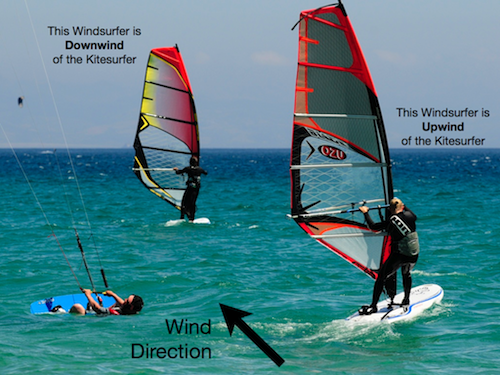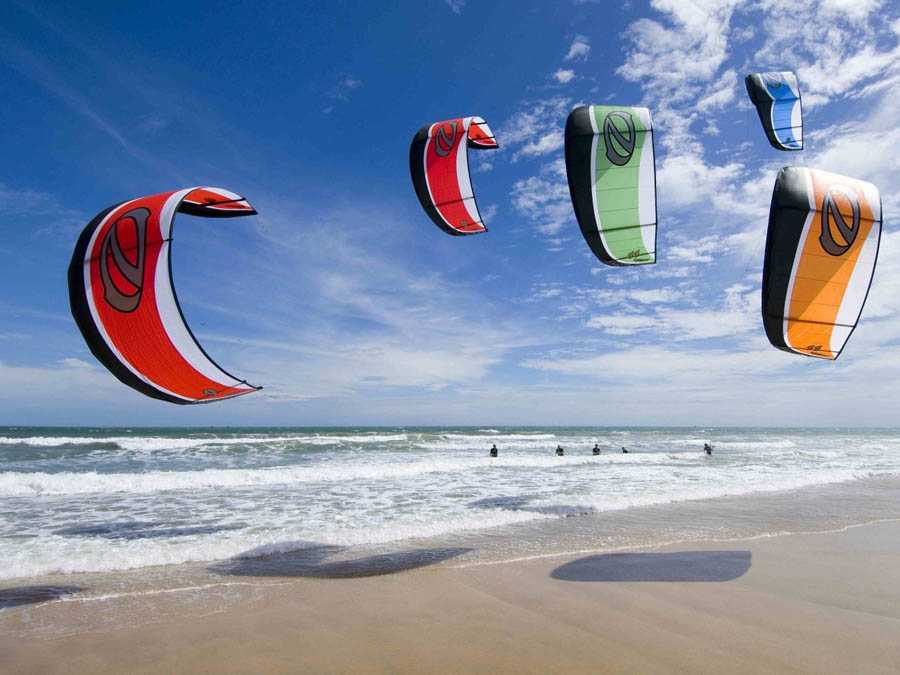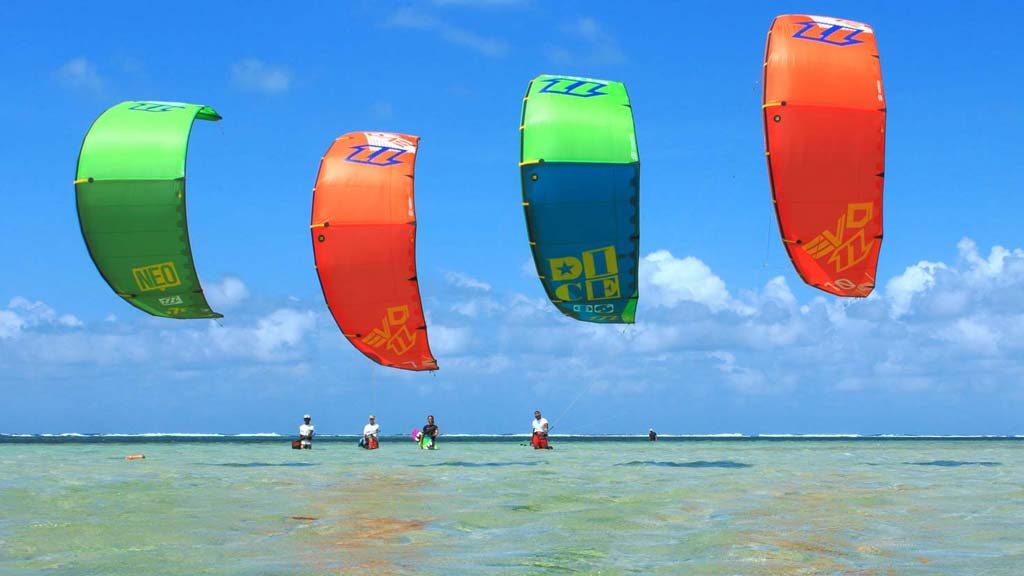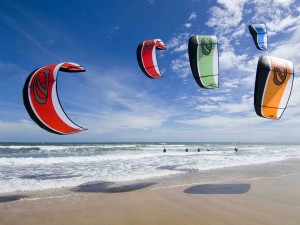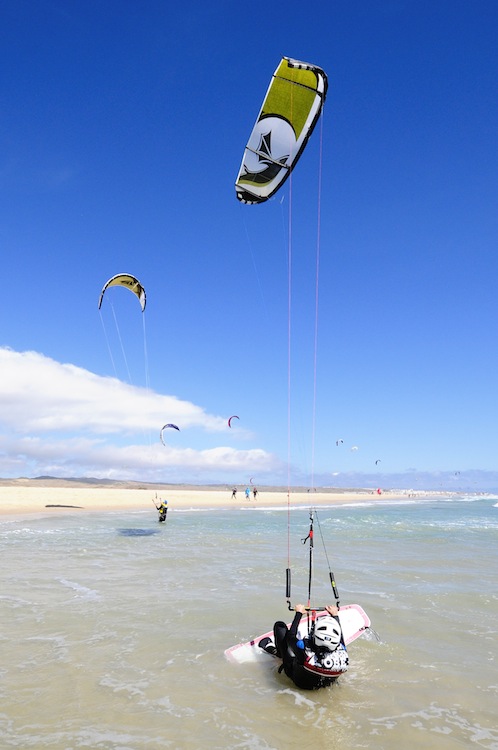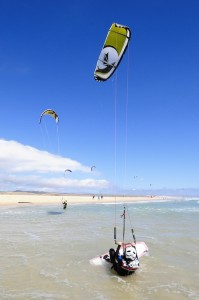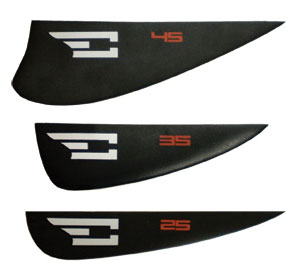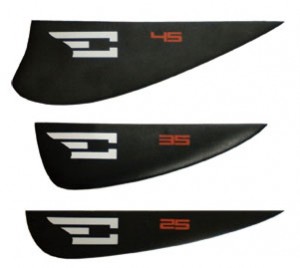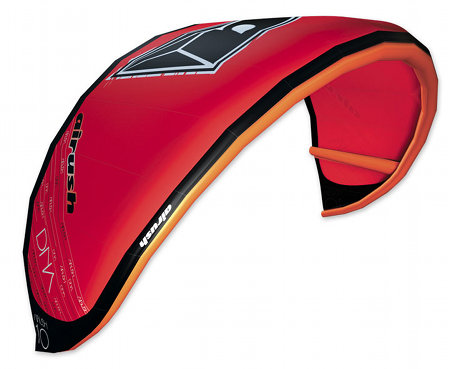

The Airush DNA comes in 4, 6, 8, 10 and 12m sizes. Designed primarily as a school/beginner kite it has a delta-hybrid design with a full flag-out safety system. It is based on the Airush Lithium kite but is built to be stronger and easier to handle for the beginner. We first got our hands on one of these about a month ago and have been using them ourselves and in the school for teaching ever since.
When you unroll the kite the first thing you will notice is that it is simple. The bag is functional (and not much more) the kite has no 1 pump system, the graphics are again functional but uninspiring. First impressions of this kite are not great. That said however the kite looks well put together and it was due to the legends of its tough design that we were attracted to them in the first place. Its still too early in the season to say how they will stand up but if the reports from last years model hold true we hope to be impressed.
Put the kite in the air and everything changes. The kite performs amazingly in all conditions, and I mean all! We’ve had this kite out in horrendously gusty conditions here in Tarifa where the wind is blowing from 5 kts up to 30 kts and it it still possible to teach. More impressively in really light winds where there are huge holes in the wind the kite will cope with the lulls much better than anything I have ever seen before staying in flight for an age with next to no wind before it starts to drop. Compared to the kites we’ve taught on in the past and by looking at the other kites on the beach I can honestly say it seems to perform the best across the widest range of conditions.
We (and the other schools teaching on DNA’s) are regularly the schools with the first kite up as the wind builds and last kite down when it dies. The kite seems almost impossible to back or front stall, simply powering up as you pull the bar in or dropping back in the window if it overshoots the window. The kite keeps its power and distance in the turns and even when you’re really flinging it around will keep tension in the lines. It relaunches effortlessly even in light winds. All this combines to give us more teaching time and a better advancement rate with our clients than we’ve ever had in the past.
More than simply a school kite however I have to say I really love riding this kite, sure it’s not the most dynamic kite in the world but it just makes kiting hassle free. Mess up a jump and land with the kite upwind, the kite simply moves back into position over your head. Struggling in light winds? Just pull the bar in and instead of that awful back stall sensation the kite simply shifts back slightly in the window and then continues to power up. The kite seems to relaunch using the force and is almost effortless…time after time. Again this isn’t a kite that will have the pro’s raving but as a functional, easy to use, 1st time kite I do not believe this kite can be beaten by anything I’ve ever ridden or taught on.
There are of course some down sides. The kites not the most beautiful and you’re mates certainly wont be jealous the first time you pull it out of its bag! The graphics are simple and the colours are not the most eye catching. It is not blisteringly fast and if your after a radical ride this probably isn’t the kite for you. I can’t imagine Ruben Lenton wanting to fly a kite like this for very long as it simply doesn’t feel like it’s built for performance.
In short the DNA’s simplicity is it’s greatest strength. It is possibly the best beginner/school kite on the market but is also great for intermediates who simply want hassle free kiting. With its amazingly stable flight and relaunch characteristics it’ll keep you kiting in conditions that before you wouldn’t have thought possible or wanted to brave. That said if you’re looking for a radical kite to perfect your f-16’s on, this maybe isn’t the kite for you.
Update after 1 Year’s Use In The Kite School
Although a superb kite to teach on we won’t be buying the DNA’s next year for our school as we simply found them too fragile for the kind of rough treatment they get whilst being used in our kite school. I still love the kites to fly, but they seem to have just too many weak points, many caused by over reinforcement of certain areas, ie. the ‘pads along the trailing edge. This leads to the material around the reinforcement being put under too much pressure and consequently breaking under the strain.
Tried the Airush DNA and want to let us know what you think? Let us know in the comments below…
